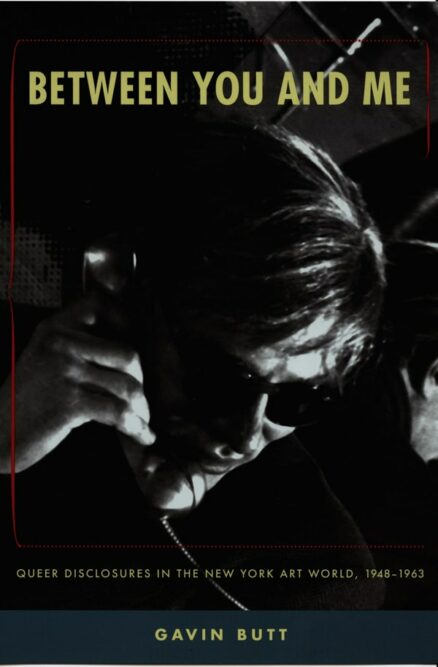Between You and Me
Queer Disclosures in the New York Art World 1948-1963
Published January 2005
Duke University Press Combined Academic PublishersIn the decades preceding the Stonewall riots—in the wake of the 1948 publication of Alfred Kinsey’s controversial report on male sexuality and in the midst of a cold war culture of suspicion and paranoia—discussions of homosexuality within the New York art world necessarily circulated via gossip and rumor. Between You and Me explores this informal, everyday talk and how it shaped artists’ lives, their work, and its reception. Revealing the “trivial” and “unserious” aspects of the postwar art scene as key to understanding queer subjectivity, Gavin Butt argues for a richer, more expansive concept of historical evidence, one that supplements the verifiable facts of traditional historical narrative with the gossipy fictions of sexual curiosity.
Focusing on the period from 1948 to 1963, Butt draws on the accusations and denials of homosexuality that appeared in the popular press, on early homophile publications such as One and the Mattachine Review, and on biographies, autobiographies, and interviews. In a stunning exposition of Larry Rivers’s work, he shows how Rivers incorporated gossip into his paintings, just as his friend and lover Frank O’Hara worked it into his poetry. He describes how the stories about Andy Warhol being too “swish” to be taken seriously as an artist changed following his breakthrough success, reconstructing him as an asexual dandy. Butt also speculates on the meanings surrounding a MoMA curator’s refusal in 1958 to buy Jasper Johns’s Target with Plaster Casts on the grounds that it was too scandalous for the museum to acquire. Between You and Me sheds new light on a pivotal moment in American cultural production as it signals new directions for art history.
“Between You and Me is a brilliant read that flirtatiously winks and kisses its way through the New York art world of the postwar period, turning our favorite icons inside out and back in again. Taking gossip into his own mouthy hands, Butt slurs the studios of Rivers, Jasper Johns, and Andy Warhol with their own reckless talk: kisses turn into smacks, and winks into home runs. (Between you and me, that’s how I like it.)” – Carol Mavor, author of Reading Boyishly and Black and Blue
“Addressing gossip as a Derridean supplement to standard forms of historical evidence, Butt aims to queer the writing of history. He does a provocative job, largely by confronting authoritative knowledge with its unverifiable counterparts.” – Frazer Ward, GLQ
“Between You and Me is boldly original and beautifully written. Gavin Butt renders a rich (which is to say dishy) description of a queer past that might enable us to imagine a queer futurity. His book will stand as a lasting contribution to queer theory and visual cultural studies and, perhaps more importantly, serve as a political and methodological wake-up call to the discourse of art history.” — José Esteban Muñoz, author of Cruising Utopia: The Then and There of Queer Futurity
“Easily accessible to art historians and non-scholars alike, Between You and Me’s performative interpretations of artistic and sexual identities through biographic remembrances and iconographic interrogations of art objects and gallery installations trouble the stability of verbal and visual evidence, critically examining the nature of what we consider to be useful evidence while expanding the term to include innuendo, rumor, and imprecise visual cues. Butt flirts with impropriety here, taking obvious personal and scholarly pleasure in writing an account of mid-twentieth-century gossip that aggressively queers traditional art historical practice, forcing us to reconsider the ways in which we narrate history.” — Stefanie Snider, CLGH Newsletter
“Gossip, [Butt] notes, is conventionally thought to be slight because it is not serious.… Butt shows how much you can learn about recent American art by looking at the gossip associated with it.” — David Carrier, artUS
